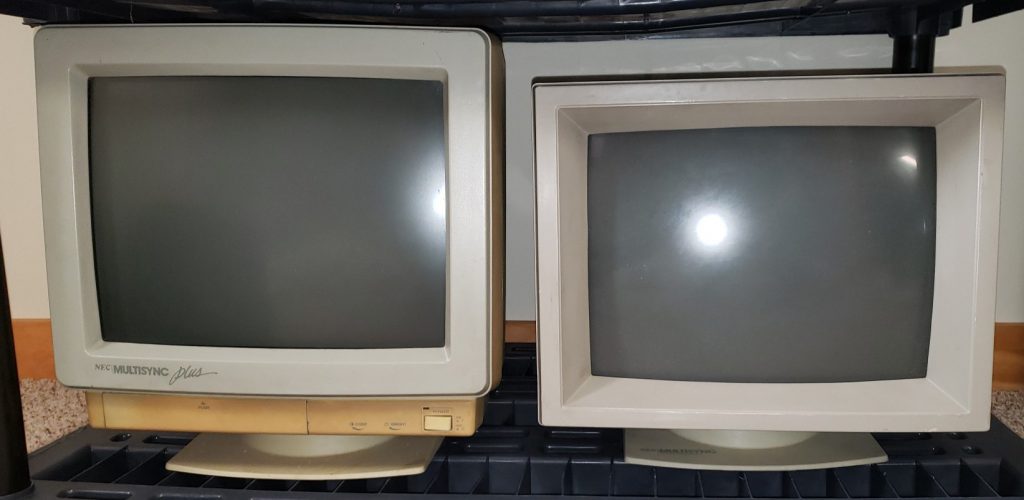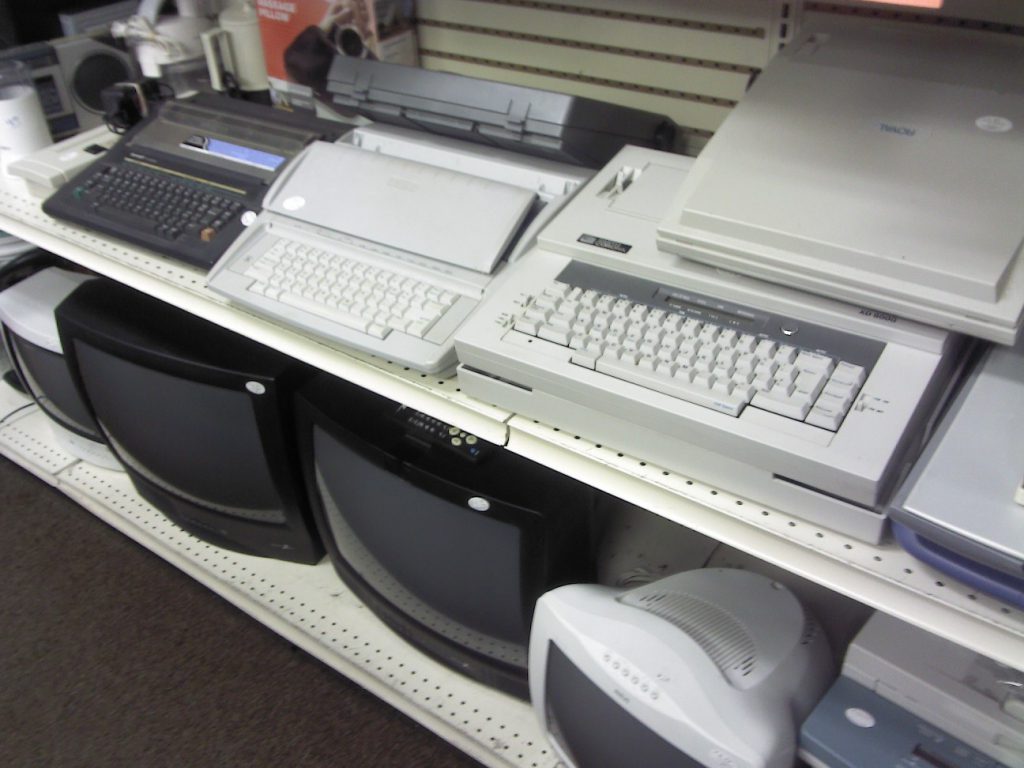Note: This article focuses on the advantages and disadvantages of CRT Computer Monitors (VGA-based), as opposed to TVs. While I’m well aware of the world of PVMs, RGB/SCART and upscalers, this is primarily a computer-related blog, so for now I’ll stick to the 30KHz+ computer-related peripherals.

Left: NEC MultiSync PLUS (JC-1501VMA – 1988), Right: NEC MultiSync (JC-1401P3A – 1986)
See Also: NEC MultiSync II (JC-1402HMA – 1988)
Introduction
When you deal with the computer industry night-and-day like I do, it’s difficult not to notice trends. Growing up, we just used CRTs as our computer monitors, and we thought little of it. Although we had beautiful, color, active-matrix LCD displays at that time (like the one found on the IBM PS/2 CL57SX laptop), finding them as standalone monitors was fairly rare. They just didn’t have the resolution, the right price point, or – most importantly, at the time – the size. Think of it this way: in 1995, the largest laptop LCD panel was 10.4″. On the other hand, people were typically using 15″ CRTs, and 17″ ones were coming down in price. We got our first 19″ in 1998, and our first 21″ in 2001.
Other disadvantages of competing technologies included the viewing angle, response rate, and resolution flexibility. CRTs could often go up to ridiculous resolutions, such as the late-90s NEC MultiSync P1250+, which could go up to 1800×1440 @ 72 Hz, or 800×600 @ a whopping 160 Hz. For comparison, it took me until 2012 – FOURTEEN years! – to finally get an LCD monitor that could match the NEC’s 1440 vertical pixels, and that cost me $800 in 2012 dollars. It took another 5 years or so before the “refresh rate wars” kicked in – now, people want 100+ Hz monitors, FreeSync, etc. to play their games more fluidly. But alas, with CRTs, we had all of that 20 years ago… although the graphics cards of the time weren’t necessarily able to draw game graphics that quickly.
So what’s the trend I mentioned at the beginning of the article? From what I’ve seen over the last 3 years, these have been making a comeback! Many, many years after I swore these things off – mainly due to two of them failing in spectacular ways while I was using them within 4 years – they’re back.
The Comeback
Of course, there was a long period of time where these were simply being thrown away en masse (I would say 2007-2017). Here are some pictures I took with my Android smartphone, in early 2012. They were everywhere!
Notice the prices visible on some of the TV sets – $4.99 USD, $6.99 USD… I remember the largest one there being $7.99. These were the final, retail prices, not starting bidding prices. The day I took that first picture (in Goodwill), I ended up buying one of the TV sets in the pile. It was a 2001 Toshiba (13″) TV/VCR combo, and cost a total of $2.99! I remember semi-randomly picking it from a pile of dozens, handing the lady three singles ($1 bills) at the checkout, then driving off with it. Yes, at one point in time, it was really that easy to collect them.
I continued to see CRT TVs on the side of the road until about 2017. This seems to mirror what other people on forums have experienced – there was a sharp cutoff right around that point in time. I personally turned down several CRT monitors (and TVs) that year, and they were being offered to me for free.
The Advantages
So what do CRTs offer today that other technologies don’t? Here is a somewhat biased list of benefits, which may or may not be relevant to YOUR workflow:
- No fixed/native resolution. LCD panels have one resolution: the native resolution. All other resolutions are stretched to fit. CRTs do not have a fixed array of pixels (although they may have a shadow mask or aperture grille of varying specs).
- High resolution and refresh rate. This stopped being the biggest advantage after 4K displays came into the picture around 2014; however, refresh rate is still lacking on some newer LCD-based displays.
- Non-widescreen format. This is important for the retro-gaming community, as standard-definition games (including old MS-DOS games) almost exclusively look better on a 4:3 monitor. For people that do productive work instead of watch movies, CRTs are also better, as they typically used 4:3 or 5:4 resolutions. Some of the later ones, like the SONY GDM-FW900, were widescreen, but the majority were not. (Of course, there were several widescreen CRT TVs, such as SONY’s XBR line, but we’re mainly talking about computer monitors here). One common argument I hear is that widescreen is better because you can fit two documents side by side. This is true, but nothing beats the adrenaline rush of having a cheap particleboard desk with two 90-lbs CRTs on it.
- Near-instant response rates. IPS screens, OLEDs, etc. have lag, especially with digital conversions taking place. Digital conversions are now the only path forward for new equipment, since the NVIDIA 980ti was widely regarded as the last mainstream graphics card to have an analog (DVI-I) output, and it was discontinued in 2016. The newer cards typically only have DVI-D (digital) outputs, which work with CRTs as long as you use an active signal converter, which introduces more lag and often doesn’t work with ridiculously high resolution/refresh rate combos, like pure analog would. NOTE: There can be a persistence-of-vision effect with CRTs (considering that’s literally how they work). The worst offender of this is the early long-persistence monitors, like the IBM 5151 green-screen: you can see text for several minutes after it disappears. In general, though, there is much less “ghosting” associated with CRTs than with the early IPS LCD screens.
- Superb contrast. The color ‘black’ is literally rendered as the absense of light. This is the same on OLED, but with LCD, you may see bleed from the backlight(s).
- The beautiful scanlines! Wait, what? I thought we were all trying to get rid of scanlines? Nope, there’s a generation of people out there that romanticize them, and consider thicker scanlines to be better. I can certainly understand this, especially in the retro gaming community, where certain games are literally designed around exploiting CRT’s manneurisms (look up “Sonic Waterfall CRT” for an example on transparency effects that only work on CRTs)
- Certain things will only work on CRT monitors. The best example of this is the NES Zapper “Light Gun”. These don’t work on HD CRTs (due to the lag) or LCDs (due to refresh rate). Another example of lost functionality would include older watches and PDAs. Some of these used a lens to “see” flickering patterns of lines on a monitor, which was used as a way to transmit data.
- They double as space heaters. To be fair, though, some of the older LCDs (such as the late-2000s 1920×1200 CCFL-lit monitors) could use over 100 Watts as well. This stopped being the case once LED backlighting (to replace the fluorescent-based CCFL backlighting) began appearing in the desktop LCD monitor scene around 2009.
- The ‘degauss’ button. If you’ve never pressed one, find one, and press it.
To sum it up, if you want the best contrast, colors, brightness, resolution and light weight, go with OLED. If you want most of these plus a near-instant response rate, go with OLED. If you want a good middle ground, stick with IPS LCD. If you want the advantages listed above, stick with CRT.
Today’s Practical Uses
If you’re a retro computer collector, there are also a few practical reasons to keep a CRT around. One of my oldest monitors, an original NEC MultiSync, can sync down to 15 KHz, meaning it’s compatible with MDA, Hercules, CGA, MCGA, EGA, VGA, and SVGA, including TTL signals (from an original IBM PC, for example). It has a switch for TTL/ANALOG, and another switch for TEXT Mode. While in TEXT Mode, you can use the monitor’s individual R/G/B switches to change the text color. I’ve successfully used it with a TTL signal from an original PC, as well as driving it all the way to 800×600 (SVGA) on a more modern laptop.
Other people have found success using CRT VGA monitors in place of rarer, more expensive studio TVs such as PVMs and BVMs. Unfortunately, most VGA monitors don’t sync any lower than 30 KHz, so you usually need to find a way to “convert” the 15 KHz signal from a game console. (If you want a genuine, scanline-y picture from a Raspberry Pi, you can sometimes use 320×240 at 120 Hz, which counts as 30+ KHz.)
Although I no longer have most of my CRT monitors, I still have a few left that have stood the test of time. You may eventually see some articles about them on here.
Revised on June 20, 2022



Recent Comments